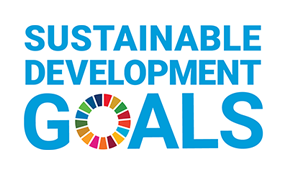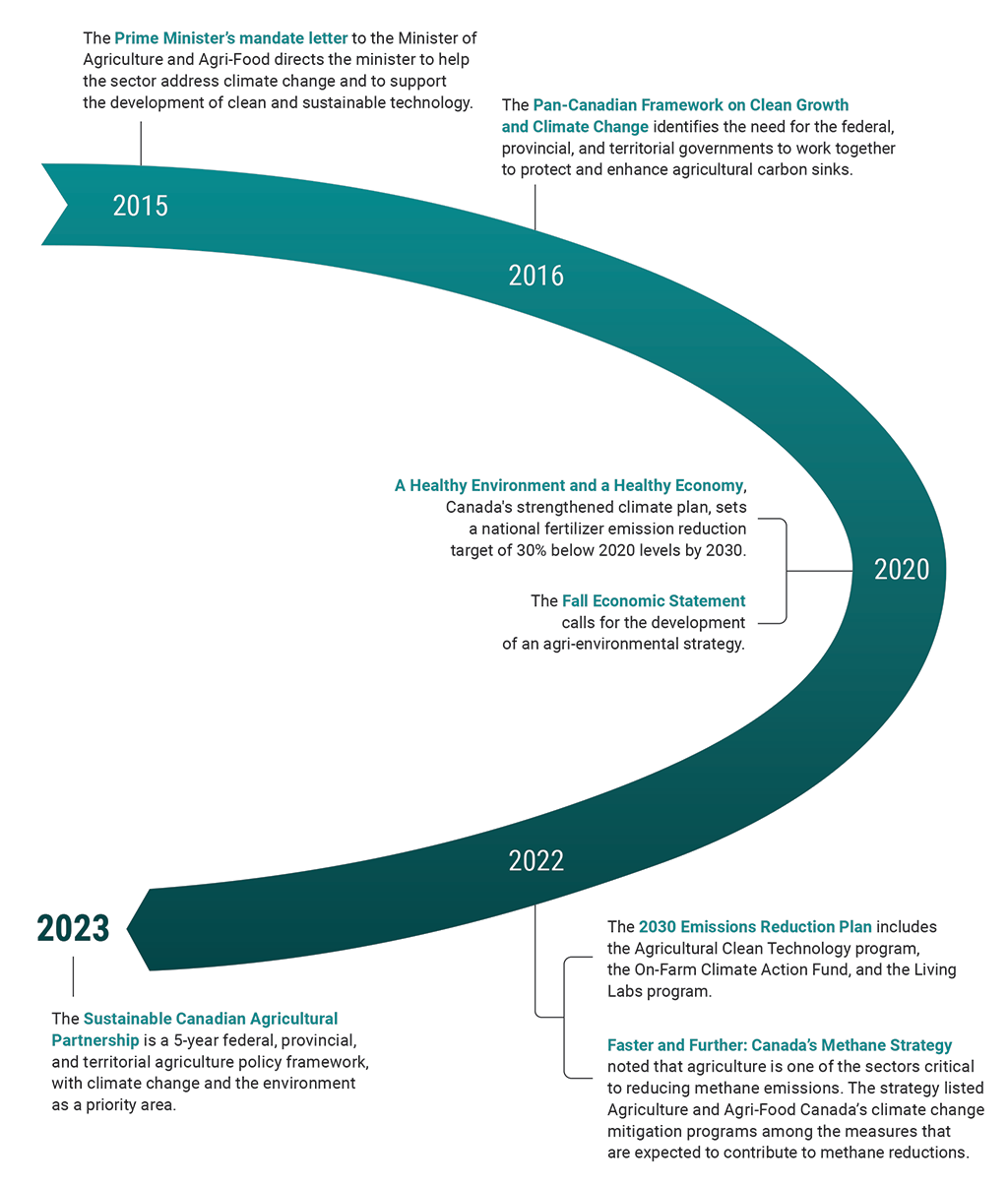2024 Reports 1 to 5 of the Commissioner of the Environment and Sustainable Development to the Parliament of Canada
Report 5—Agriculture and Climate Change Mitigation—Agriculture and Agri-Food Canada
At a Glance
Since 2015, Agriculture and Agri‑Food Canada has been mandated to act on climate change, and in 2020, the federal government called on the department to develop a strategy to address climate change mitigation in the agriculture sector. Despite this, the department had yet to develop a strategy for how it would contribute to Canada’s 2030 and 2050 greenhouse gas mitigation and sequestration goals. In the absence of this strategy, we found that the department had undertaken extensive science-based work that informed its current climate change programming.
In 2021, Agriculture and Agri‑Food Canada launched 3‑key programs aimed at reducing greenhouse gas emissions; however, the department’s delays in funding approvals resulted in recipients missing a growing season, which limited the greenhouse gas reduction results achieved by January 2024. In addition, 2 of the 3 programs had not yet set or finalized all of their performance targets for climate change mitigation. The department’s contributions to reduce greenhouse gas emissions under its programs are integral to the fight against climate change, which is why setting targets and tracking results are so important.
Furthermore, without a strategy to provide the sector with a long‑term vision and direction, the department’s path to help achieve Canada’s 2030 and 2050 goals remains unclear. Given the current climate crisis and limited results by January 2024, Agriculture and Agri-Food Canada will need to ensure that all its expected reductions in greenhouse gas emissions for 2030 take place in the 6 growing seasons that remain.
Key facts and findings
- Between 1990 and 2021, greenhouse gas emissions from the agriculture sector grew by 39%, mostly driven by an increase in emissions related to crop production.
- In 2021, about 10% of Canada’s total greenhouse gas emissions came from the agriculture sector, making it the fifth‑largest emitting sector.
- In 2021, agricultural soils stored 18 megatonnes of carbon dioxide equivalent, offsetting approximately 26% of Canada’s total annual agricultural emissions.
- By January 2024, funding disbursed under the On‑Farm Climate Action Fund program had resulted in 4,338 producers adopting beneficial management practices; and 1,320,000 hectares of land under improved management.
- By January 2024, funding disbursed under the Agriculture Clean Technology program resulted in 193 new agricultural clean technologies adopted by producers.
- Between May 2022 and June 2023, Agriculture and Agri‑Food Canada approved 14 living labs across Canada, with every province having at least 1 living lab.
- Delays in the review and approval of applications to the department’s 3 key climate change mitigation programs delayed project implementation and results.
Why we did this audit
- The agriculture sector can play a key role in mitigating climate change through agricultural management practices that reduce emissions of greenhouse gases and remove carbon dioxide from the atmosphere.
- Climate change is a complex, long‑term problem, and having a strategy for Canada’s agriculture sector would establish transformational goals and targets. A strategy would also support collaboration with federal partners, other levels of government, Indigenous peoples, and sector stakeholders.
Highlights of our recommendations
- To ensure that Agriculture and Agri‑Food Canada can meaningfully contribute to Canada’s 2030 and 2050 climate change targets, including the fertilizer and methane emission reduction commitments, the department should finalize and implement a sustainable agriculture strategy.
- To enable the accurate, timely, and transparent assessment of results and the ability to roll up greenhouse gas emission reduction data across its projects and programs, Agriculture and Agri‑Food Canada should implement a results monitoring framework.
Please see the full report to read our complete findings, analysis, recommendations and the audited organizations’ responses.



Canada’s Federal Sustainable Development Strategy sets out the Government of Canada’s goals, targets, and plans to implement the 2030 Agenda for Sustainable Development and the United Nations’ Sustainable Development Goals. Every goal in the federal strategy is aligned with a specific United Nations’ Sustainable Development Goal. The federal goals that the department was responsible for and that are most relevant to this audit are:
- Goal 2 (Support a Healthier and More Sustainable Food System) which is aligned with the United Nations’ Sustainable Development Goal 2 (Zero Hunger)
- Goal 13 (Take Action on Climate Change and Its Impacts), which is aligned with the United Nations’ Sustainable Development Goal 13 (Climate Action)
Visit our Sustainable Development page to learn more about sustainable development and the Office of the Auditor General of CanadaOAG.
Exhibit highlights
Selected commitments by Canada to mitigate climate change in the agriculture sector, 2015–2023

Source: Based on information from various federal government sources
Text version
This timeline shows selected commitments by Canada from 2015 to 2023 to mitigate climate change in the agriculture sector.
In 2015, the Prime Minister’s mandate letter to the Minister of Agriculture and Agri-Food directs the minister to help the sector address climate change and to support the development of clean and sustainable technology.
In 2016, the Pan‑Canadian Framework on Clean Growth and Climate Change identifies the need for the federal, provincial, and territorial governments to work together to protect and enhance agricultural carbon sinks.
In 2020, A Healthy Environment and a Healthy Economy, Canada's strengthened climate plan, sets a national fertilizer emission reduction target of 30% below 2020 levels by 2030.
Also in 2020, the Fall Economic Statement calls for the development of an agri-environmental strategy.
In 2022, the 2030 Emissions Reduction Plan includes the Agricultural Clean Technology program, the On-Farm Climate Action Fund, and the Living Labs program.
Also in 2022, Faster and Further: Canada’s Methane Strategy noted that agriculture is one of the sectors critical to reducing methane emissions. The strategy listed Agriculture and Agri-Food Canada’s climate change mitigation programs among the measures that are expected to contribute to methane reductions.
In 2023, the Sustainable Canadian Agricultural Partnership is a 5-year federal, provincial, and territorial agriculture policy framework, with climate change and the environment as a priority area.
Examples of greenhouse gas emissions and removals from Canadian agricultural activities

Source: Adapted from Agriculture and Agri‑Food Canada
Text version
This illustration shows examples of greenhouse gas emissions and removals from Canadian agricultural activities on a farm.
Crop and livestock production release methane and nitrous oxide. Cows emit methane—either by their digestive process or from decomposition of their manure. Soils release nitrous oxide following fertilizer and manure application.
On-farm energy use from using fossil fuels to operate farm equipment and to heat buildings releases carbon dioxide, while crops planted in the soil can store carbon dioxide. Soils also serve as a sink to remove carbon dioxide from the atmosphere in a process called soil carbon dioxide exchange.
Infographic

Text version
Agriculture and Climate Change Mitigation
Agriculture and Agri‑Food Canada had not developed a strategy for how the agriculture sector would contribute to Canada’s 2030 and 2050 climate goals, as was first called for in 2020.
Highlights
Agriculture and Agri‑Food Canada has a goal of reducing greenhouse gas emissions by 11 megatonnes of carbon dioxide equivalent by 2030. The department has so far achieved less than 2% of its 2030 overall reduction target. It will need to ensure that all reductions for 2030 take place in the 6 growing seasons that remain.
Overview of greenhouse gas emissions from the agriculture sector
A graph shows the percentages of greenhouse gas emissions by sector in Canada in descending order as follows:
- oil and gas (28%)
- transportation (22%)
- buildings (13%)
- heavy industry (12%)
- agriculture (10%)
- electricity (8%)
- waste and other (7%)
The graph also shows the percentages of greenhouse gas emissions from the agriculture sector in Canada in descending order are as follows:
- animal production (51%)
- crop production (28%)
- on‑farm fuel use (21%)
The graph is adapted from Canada’s National Inventory Report 1990–2021: Greenhouse Gas Sources and Sinks in Canada, Environment and Climate Change Canada, 2023.
Between 1990 and 2021, greenhouse gas emissions from the agriculture sector grew by 39%, mostly due to crop production
A line graph shows the amount of greenhouse gas emissions emitted by the agriculture sector in Canada from 1990 to 2021. During this period, the amount of emissions grew by 39%, from 49.4 megatonnes of carbon dioxide equivalent in 1990 to 68.6 megatonnes of carbon dioxide equivalent in 2021.
The yearly amounts of agriculture sector greenhouse gas emissions from 1990 to 2021 are as follows.
| Year | Megatonnes of carbon dioxide equivalent, rounded |
|---|---|
| 1990 | 49.4 |
| 1991 | 49.6 |
| 1992 | 51.6 |
| 1993 | 52.8 |
| 1994 | 54.5 |
| 1995 | 56.9 |
| 1996 | 58.4 |
| 1997 | 59.3 |
| 1998 | 59.4 |
| 1999 | 59.6 |
| 2000 | 60.6 |
| 2001 | 60.2 |
| 2002 | 59.7 |
| 2003 | 61.6 |
| 2004 | 62.7 |
| 2005 | 63.7 |
| 2006 | 62.2 |
| 2007 | 62.4 |
| 2008 | 61.9 |
| 2009 | 59.2 |
| 2010 | 59.5 |
| 2011 | 60.2 |
| 2012 | 62.5 |
| 2013 | 64.4 |
| 2014 | 63.4 |
| 2015 | 64.9 |
| 2016 | 66.0 |
| 2017 | 66.5 |
| 2018 | 68.5 |
| 2019 | 68.9 |
| 2020 | 69.8 |
| 2021 | 68.6 |
The source of this graph is Canada’s National Inventory Report 1990–2021: Greenhouse Gas Sources and Sinks in Canada, Environment and Climate Change Canada, 2023.
In 2021, the department launched 3 key programs aimed at reducing greenhouse gas emissions, but delays in funding approvals resulted in recipients missing a growing season
Agriculture and Agri‑Food Canada’s contributions to reduce emissions under the 3 programs are integral to the fight against climate change:
- The Living Labs program develops and tests innovative technologies and on‑farm practices to reduce greenhouse gases and store carbon.
- The On‑Farm Climate Action Fund helps farmers adopt beneficial management practices that reduce greenhouse gases and store carbon.
- The Agriculture Clean Technology program supports farmers to purchase and install clean technology or upgrade equipment that will reduce greenhouse gases.
Without a strategy to provide the agriculture sector with a long‑term vision and direction, the department’s path to help achieve Canada’s 2030 and 2050 goals remains unclear.
Related information
Entities
Tabling date
- 30 April 2024
Related audits
- 2023 Reports of the Commissioner of the Environment and Sustainable Development
Report 5—Emission Reductions Through Greenhouse Gas Regulations—Environment and Climate Change Canada - 2023 Reports of the Commissioner of the Environment and Sustainable Development
Report 6—Canadian Net-Zero Emissions Accountability Act—2030 Emissions Reduction Plan
